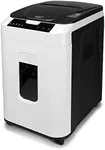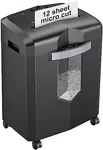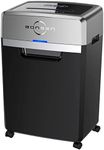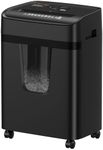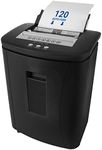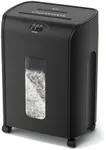Buying Guide for the Best Heavy Duty Paper Shredder
When choosing a heavy-duty paper shredder, it's important to consider your specific needs and the environment in which the shredder will be used. Heavy-duty shredders are designed for high-volume shredding tasks and can handle a variety of materials beyond just paper, such as credit cards, CDs, and staples. Understanding the key specifications will help you select a shredder that meets your requirements for security, capacity, and durability.Sheet CapacitySheet capacity refers to the number of sheets a shredder can handle at one time. This is important because it determines how quickly you can shred large volumes of paper. Shredders with a lower sheet capacity (up to 10 sheets) are suitable for light use, while those with a medium capacity (10-20 sheets) are good for moderate use. High-capacity shredders (20+ sheets) are ideal for heavy-duty use in busy offices. Choose a shredder with a sheet capacity that matches the volume of shredding you expect to do.
Run Time and Cool Down TimeRun time is the amount of time a shredder can operate continuously before needing to cool down, while cool down time is the period it needs to rest before it can be used again. For occasional use, a shredder with a short run time (5-10 minutes) and a longer cool down time (20-30 minutes) may suffice. For more frequent use, look for a shredder with a longer run time (20-60 minutes) and a shorter cool down time. If you need to shred continuously for extended periods, consider a shredder with a continuous duty motor that doesn't require cool down.
Security LevelSecurity level indicates the size of the shredded particles and is important for protecting sensitive information. Shredders are classified by DIN levels, with P-1 to P-2 providing basic security (strips), P-3 to P-4 offering medium security (cross-cuts), and P-5 to P-7 providing high security (micro-cuts). For general office use, a P-3 or P-4 shredder is usually sufficient. For highly confidential documents, opt for a P-5 or higher shredder to ensure maximum security.
Bin CapacityBin capacity refers to the volume of the waste bin that collects shredded material. This is important because it affects how often you need to empty the bin. Smaller bins (up to 5 gallons) are suitable for personal or light use, medium bins (5-10 gallons) are good for small offices, and larger bins (10+ gallons) are ideal for heavy-duty use in larger offices. Choose a shredder with a bin capacity that matches the volume of shredding you expect to do to minimize interruptions.
Shredder SpeedShredder speed is measured in feet per minute (FPM) and indicates how quickly a shredder can process paper. Faster shredders (10-20 FPM) are ideal for high-volume shredding tasks, while slower shredders (5-10 FPM) may be sufficient for occasional use. Consider the volume of shredding you need to do and choose a shredder with a speed that will allow you to complete your tasks efficiently.
Noise LevelNoise level is measured in decibels (dB) and indicates how loud the shredder is during operation. This is important for maintaining a comfortable working environment, especially in shared office spaces. Shredders with a noise level below 60 dB are considered quiet and are suitable for use in noise-sensitive environments. If noise is not a major concern, a shredder with a higher noise level may be acceptable. Choose a shredder with a noise level that matches your work environment and personal preference.
Additional FeaturesAdditional features such as jam prevention, auto-feed, and safety sensors can enhance the usability and safety of a shredder. Jam prevention features help to reduce the likelihood of paper jams, while auto-feed allows for hands-free shredding of large stacks of paper. Safety sensors can detect hands or objects near the shredder opening and automatically stop the shredder to prevent accidents. Consider which additional features are important to you and choose a shredder that offers those functionalities to improve your shredding experience.
